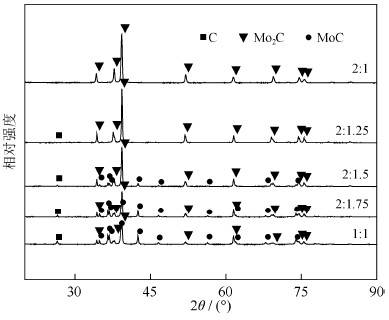| [1] |
Gong S W, Chen H K, Li W, et al. Synthesis of β-Mo2N0.78 hydrodesulfurization catalyst in mixtures of nitrogen and hydrogen. Appl Catal A, 2005, 279(1-2): 257
|
| [2] |
Sun D Y, Lin B Z, Xu B H, et al. Zr-intercalated molybdenum disulfide: preparation, characterization and catalytic activity in nitrobenzene hydrogenation. J Porous Mater, 2008, 15(3): 245
|
| [3] |
Ren J, Jin Y Z, Zhang Z Q, et al. Synthesis of Mo2C nanopowders by molten salt method. Powder Metall Technol, 2017, 35(1): 29任娇, 金永中, 张正权, 等. 熔盐合成法制备Mo2C纳米粉末的研究. 粉末冶金技术, 2017, 35(1): 29
|
| [4] |
Escandón L S, Ordóňez S, Vega A, et al. Sulphur poisoning of palladium catalysts used for methane combustion: Effect of the support. J Hazard Mater, 2008, 153(1-2): 742
|
| [5] |
Cao W C, An G, Liu G J. The properties, application and preparation methods of molybdenum carbide and molybdenum nitride. China Molybd Ind, 2006, 30(5): 45曹维成, 安耿, 刘高杰. 碳/氮化钼的性能、应用及制备. 中国钼业, 2006, 30(5): 45
|
| [6] |
Earnshaw A, Greenwood N N. Chemistry of the Elements. 2nd Ed. UK: Butterworth-Heinemann, 1997
|
| [7] |
Yang Z H, Cai P J, Shi L, et al. A facile preparation of nanocrystalline Mo2C from graphite or carbon nanotubes. J Solid State Chem, 2006, 179(1): 29
|
| [8] |
Zhang X, Li L P, Liang J. Research and development of molybdenum carbide catalyst. China Molybd Ind, 2010, 34(6): 26张新, 李来平, 梁静. 碳化钼催化剂的研究进展. 中国钼业, 2010, 34(6): 26
|
| [9] |
Osepchuk J M. A history of microwave heating applications. IEEE, 1984, 32(9): 1200
|
| [10] |
Rybakov K I, Semenov V E, Egorov S V, et al. Microwave heating of conductive powder materials. J Appl Phys, 2006, 99(2): 023506
|
| [11] |
Ham D J, Lee J S. Transition metal carbides and nitrides as electrode materials for low temperature fuel cells. Energies, 2009, 2(4): 873
|
| [12] |
Hojo J, Tajika M, Kato A. Molybdenum carbide powders obtained from the vapor phase reaction of the MoCl4–CH4–H2 system. J Less-Common Met, 1979, 66(2): 151
|
| [13] |
Zhu X K, Lin Q S, Chen T L, et al. Research and progress in mechanical alloying. Powder Metall Technol, 1999, 17(4): 291朱心昆, 林秋实, 陈铁力, 等. 机械合金化的研究及进展. 粉末冶金技术, 1999, 17(4): 291
|
| [14] |
Lin W S. Metallic phase transformation in mechanical alloying. Powder Metall Technol, 2001, 19(3): 178林文松. 机械合金化过程中的金属相变. 粉末冶金技术, 2001, 19(3): 178
|
| [15] |
Omori M. Sintering, consolidation, reaction and crystal growth by the spark plasma system (SPS). Mater Sci Eng, 2000, 287(2): 183
|
| [16] |
Yao R, Zhang X, Wang S W, et al. The properties of Mn3O4 synthesized by spark plasma sintering. Powder Metall Technol, 2016, 34(6): 434姚蓉, 张鑫, 王松伟, 等. 放电等离子烧结工艺对Mn3O4性能的影响. 粉末冶金技术, 2016, 34(6): 434
|
| [17] |
Yamamoto S, Tanamachi N, Horie S, et al. Fabrication of soft magnetic core using spark plasma sintering. J Jpn Soc Powder Powder Metall, 2000, 47(7): 757
|
| [18] |
Zhang J X, Liu K G, Zhou M L. Development and application of spark plasma sintering. Powder Metall Techonol, 2002, 20(3): 129张久兴, 刘科高, 周美玲. 放电等离子烧结技术的发展和应用. 粉末冶金技术, 2002, 20(3): 129
|
| [19] |
Sakamoto T. Sintering of molybdenum powder compacts by spark plasma sintering. Met Powder Rep, 1999, 54(2): 36
|
| [20] |
Lin WW, Song Y G. A comparative study on X-ray diffraction mineral quantitative analysis of two methods in sediments. J Earth Environ, 2017, 8(1): 78-87林伟伟, 宋友桂. 沉积物中X射线衍射物相定量分析中的两种方法对比研究. 地球环境学报, 2017, 8(1): 78
|




 下载:
下载:




